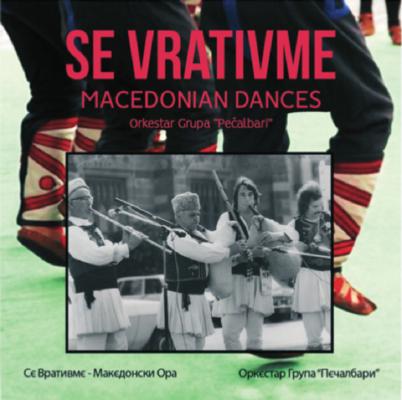The Bagpipe Society
Review: Se Vrativme: Macedonian Dances, by Orkestar Grupa “Pecalbari”
Arle Lommel
The experience of listening to Se Vrativme: Macedonian Dances, by Orkestar Grupa “Pecalbari,” was an unexpected burst of pure pleasure for me. I found it to be like discovering an old mixtape from a long-lost love hidden in the glovebox of an old car and popping it in a cassette deck. It is a love note from the past that brings up long forgotten joys.

In my case, my first real exposure to non-Scottish bagpipes was about thirty years ago, when someone gave me a bootleg copy of some archival recordings of Macedonian gajda made in the 1960s and 1970s. Sadly, I no longer have that cassette – nor even a cassette player – but something about the hiss and pops of magnetic tape and low-fi recordings takes me back to the magic of that recording. Every time I hear these types of archival recordings, made in a time before everyone could record high- fidelity sound with something pulled out of a pocket, I get a shiver down my spine. For me, this is the sound of authenticity, and nothing says it more than when it is a gajda I am listening to.
So it was with Se Vrativme (“We’re Back” in Macedonian). When I listened to it, I was instantly transported back to those first glimpses of what quickly became an obsession with drone instruments of various sorts. It isn’t the same recording, but the sound and the feel are the same and listening to it I feel a sense of self and infinite possibility I seldom encounter anymore.
Although released in April 2023 by Goatbag Music, the album recordings are from 44 years ago, when Mile Kolarov (kaval), Lazo Nikolovski (gajda), Linsey Pollak (supelka and gajda), and Chris Gunstone (then of Blowzabella, on tambura) went on tour performing what must have seemed like music from another planet to their Australian audiences. The recordings remained long hidden away, but Gunstone has started to release some of his archive recordings for more general consumption. And we will be much the better for it if this album is any indication.
As someone who started my own journey with bagpipes, hurdy-gurdies, and other drone-based instruments in the very early days of the internet, when I could email most people, I cannot imagine the complexity of the effort to arrange for musicians from Yugoslav Macedonia, the United Kingdom, and Australia to converge all together in Australia for a tour. What now could be arranged with email and a few Zoom calls would then have taken many, many hours of planning, phone calls, and physical letters to bring to pass. All this makes recordings from encounters like this all the more valuable, as a testament to the power of music to bring people together to share something deeply human.
The album itself is not like an album made today. Its bare bones, “just the facts, ma’am” approach is a blast from another era, one that reminds me of when I would hear instruments and wonder what they were and where they came
from, tantalized by minimal liner notes. It has 16 tracks, totaling 48 minutes, and each one stands on its own, although the combination and juxtaposition certainly adds value. It is led by gajda performance – 13 of the 16 tracks feature it as a solo or duet instrument – but there are also tracks with supelka and kaval (both rim-blown flutes) taking the lead or blending in with the pipes. And many of the tracks feature Gunstone’s tambura playing as a binder, with one track as a tambura solo. It is a testament to the musicianship of both Pollak and Gunstone that there is never a moment in the recording when I felt like I was listening to anything other than a crack Macedonian band. All the recordings are tight and enjoyable, with no tension, misstep, or auditory accent to spoil the experience, something that affects many albums by musicians playing out of their usual traditions.
At the same time, one of the aspects I most enjoyed is that the recordings are “real.” There are moments when you can hear that it is honest-to-goodness humans playing these instruments. For example, at a few points I could heard drones do some of the funny acoustic things that drones are wont to do (such as warble or sound the wrong pitch briefly). These are things most groups now would probably edit out of their recordings in pursuit of a “perfect” product, but I enjoy hearing a more faithful rendition of an actual performance when musicians face less than perfect conditions and yet pull together to deliver an outstanding performance. Here the archival or field feeling of these performances make them all the more enjoyable: as the listener, you are experiencing something real, not something sanitized and packaged. It’s a bit like sitting down to have a beer with a movie star versus watching one on screen.
Another touch I appreciated is that the instruments in the recording retain some of the non-western temperament characteristic of older performance that is sometimes lost in more recent recordings. For example, the track
“Sandosko ora” really emphasizes pitches noticeably off from equal temperament, but this just contributes to the “raw” feeling without in any way detracting from the performance. When you listen to it, you know this isn’t something from the bargain bin “world beat” CDs at the local multiethnic gifts store.
A personal favorite in the sequence is the track “Sitno Kicevsko,” a solo gajda performance from Lazo Nikolovski. A virtuosic example of gajda playing, it highlights the rhythmic potential of the instrument when Niklovski uses the bell note on the chanter to provide a staccato punctuation to the florid melodic line, occasionally breaking any potential monotony in that rhythm with a higher note.
The effect is almost hypnotic in its alternation between the lower notes and the melody and makes it sound almost like there are two instruments playing at once.
Another standout is “Skudrinka,” a track which highlights the strengths of all the musicians with a great interplay between the breathy flute-like sound of Mila Kolarov on the kaval and the earthy robustness of Lazo Nikolovski and Linsey Pollak on gajda. Although Gunstone’s tambura never comes to the forefront in it, its constant presence gives a drive and continuity that makes this piece work as it moves back and forth.
Overall, if you have an interest in Balkan bagpipe traditions, or Balkan music in general, this album is a time capsule from a point when it took work to find any bagpipe music that didn’t come titles like “20 Greatest Highland Bagpipe Hits”. For those who remember that era, this will take you back to a time when you had more hair and weighed a few pounds less. For those of you who still have your hair and your waistline, this is your chance to experience the real deal from masters of their craft from before you could access everything with a tap on a smartphone.
The recording can be found on Bandcamp at
https://orkestargrupapecalbari.bandcamp.com/album/se-vrativme-macedonian-dances or http://www.goatbag.com/
- Data Processing Notice (GDPR)
-
@BagpipeSociety on X (formally known as Twitter)
-
TheBagpipeSociety on Instagram
-
 BagpipeSociety on Facebook
BagpipeSociety on Facebook
Something wrong or missing from this page? Let us know!
